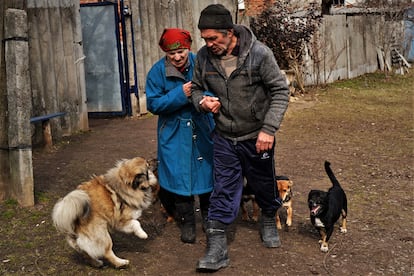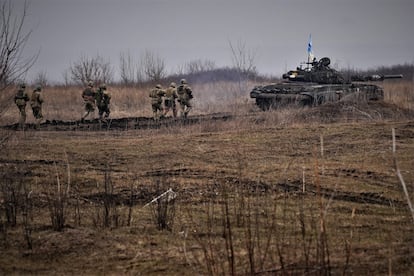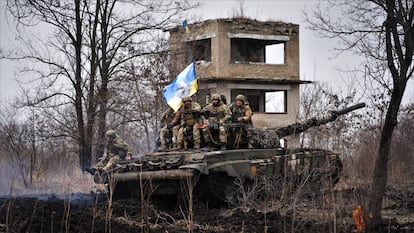Waiting for Leopard tanks on the Kharkiv front: ‘We don’t have what we need for the counteroffensive’
Local troops in Dvorichna withstand the pressure of the invaders, but demand the necessary weapons to push them back
A soldier raises his arm from the shoulder to stop the two-vehicle humanitarian convoy. He does not require papers or any other kind of passage control. He only asks for water to continue digging with his companions. They are part of the groups of uniformed men building new trenches and fortifying defense positions on the tracks in the east of the Kharkov region leading from the town of Kupiansk to villages like Dvorichna.
This enclave, where volunteers go to evacuate civilians living under constant shelling, is on the front line between the Ukrainian and Russian armies. There, as well as on other fronts, Kiev is waiting for the new armament promised by the allies, especially ammunition and tanks, such as the six German-made Leopards announced by Spain. Poland, with four, and Norway, with eight, are the first countries that have already delivered them. President Volodymir Zelenski himself, impatiently urged and implored the European Union to speed up the delivery of weapons at the summit of the leaders of the Twenty-Seven which concluded this Friday in Brussels.
In the meantime, it will be complicated for Ukrainian troops to advance, according to local authorities in Kharkiv. “To defend ourselves we have enough, but for a counteroffensive we don’t have what we need. That is my personal opinion,” Andrii Besedin, mayor of Kupiansk, acknowledges.
The popular Soviet T-72 tank models “have numerous flaws,” points out Arnaut, the nickname of a 28-year-old Ukrainian who has been in the army since 2018 and is today commanding a battalion of the 3rd Tank Brigade deployed in eastern Ukraine. During some maneuvers in the Kharkiv region, he does not openly complain about the weaponry they have and comments that they have tanks and ammunition. But at the same time, he adds, “it is no secret” that the enemy is now better equipped and that Ukraine needs models such as the Leopard. With them, he believes, they will improve their accuracy and speed of reloading and firing.

Europe, however, should not focus solely on the number of tanks Ukraine needs in the medium term, “about 150 acceptably modern ones,” says Christian D. Villanueva, editor of the magazine Ejércitos. The allies should not neglect spare parts and maintenance, he asserts. “Tanks by themselves are not going to change the war. They will perform better than Russian tanks for sure, but if they are not used in the right way, or if they become single-use systems, which when they break down are left lying around because of an inability to put them back into service, the European effort will not do much good,” Villanueva concludes.
Dovorichna is the last position in Ukrainian hands, one of the points where last September their major counteroffensive to liberate areas occupied by Kremlin troops was halted. The village overlooks the Oskil River, which serves as a border between the two armies and which the Russians are trying to cross back to its western bank. Daily fighting is taking place around a river that runs almost parallel to the demarcation between the Kharkov and Lugansk regions in the Donbas stronghold, which is almost entirely controlled by the Russians.
The Russians are making “a lot of efforts to get back,” analyzes Slava, 37, the head of an infantry company who prefers not to give his last name. “But the situation is totally unpredictable for both sides,” he adds. Around the river “there is a lot of tension, but let me not give you all the details,” he says during a conversation at a break in the maneuvers his men are carrying out together with members of the Third Tank Brigade, which took part in the blow they dealt to the enemy in September. He makes no secret of the fact that the Oskil is of vital importance, even though it is just a stream, especially when compared to the great Dnieper, one of the largest rivers in Europe, which flows through Ukraine.
V for victory
In these exercises there are soldiers, like Slava, already experienced in the war in the Donbas since 2014 and others who have been joining the ranks since Russian President Vladimir Putin invaded Ukraine on a large scale on February 24 last year. And there are even much older ones, like 56-year-old commander Oleksandr Timochenko, who amid the roar of T-72 gunfire explains that these men have been deployed in the Donetsk and Zaporiyia regions. “Now we have withdrawn them from the front to rest, repair the tanks, improve their training and coordinate with the infantry to manage to make the enemy retreat,” he details. As they pass perched on top of the tanks, some of them make the V for victory with their fingers or raise their fists while smiling optimistically.
“Additional armor and electronics are fundamental” in determining whether one tank model is better than another, says military analyst Jesús Manuel Pérez Triana. Electronic advances are what make it possible to ensure that “where you put the eye you put the bullet” regardless of atmospheric conditions, distance or whether it is nighttime.
In general, adds the analyst, “Westerners have more armor and are heavier. The Soviets opted for faster, smaller and more elusive tanks. It is rare for them to exceed 50 tons, while the Western ones rarely go below 60 tons. The improvements in each model are significant, he insists. That’s why asking for a T-72, without specifying which type, “is like asking for an iPhone without specifying which model”. Spain, for example, has the Leopard 2E, much more modern than the six units -maybe even 10- of the 2A4 model that will be delivered to Ukraine.

“In overall terms, the Leopards are much better tanks than the T-72s,” says Villanueva, referring to the 2A4 and 2A6 that Ukraine has yet to receive. The Soviet tanks carry a crew of three military personnel, compared to four for the larger Germans. “Although they suffer from a heavier weight,” Villanueva has no doubt that the Leopards are above them because “they are better protected, have better optics and targeting systems, the ammunition is more advanced, the communications and battlefield management equipment is more modern...”
In any case, another “fundamental element is training”, he adds, because “the Spanish instructors admit that with a five-week course they are very limited, as it takes time to get the most out of such a complex tank”. He is referring to the 55 Ukrainian tank drivers who have been trained in Zaragoza by Spanish soldiers. Coinciding with the first anniversary of the major invasion ordered by Putin, Poland delivered the first four Leopards to the Ukrainian army and this week eight arrived from Norway. They will be joined by British Challengers and American Abrams.
An entrenched front
As reinforcements arrive, artillery fire is constant on Dvorichna. The incoming and outgoing bombardments do not cease during the hours that EL PAÍS remains in the town, almost deserted like all the surrounding areas. Faced with this entrenched and immobile front for months, Slava, the infantry chief, recognizes that now they are facing “a totally different situation”.
Last September, the counteroffensive was sudden. “That was the key that led to our success. They were relaxed, beginning to enjoy the areas they had occupied, to normalize their life there. That’s why our attacks advanced so quickly,” summarizes the military officer. In Kupiansk, what Russia considered its capital of occupied Kharkiv for half a year, even a branch of a Moscow bank was opened.

The battle front marked by the Kupiansk-Liman line remains under heavy Russian artillery fire these days by Soviet-era armored vehicles and very old tanks, the spokesman for the Ukrainian Eastern Forces Group, Colonel Serhii Cherevati, said this week. The intensity of these clashes in which artillery is in the forefront has forced Russia to dust off old tanks manufactured more than 60 years ago because of the impossibility of speeding up the production of new weapons. In the last few days, there have been movements of units of the T-54 (manufactured up to 1959) and T-55 (up to 1979), according to Conflict Intelligence Team (CIT), a group of Russian opposition analysts who consult open sources to provide details of the war.
Russia has lost half of its most modern tanks since the major invasion of Ukraine began, according to a report last month by the International Institute for Strategic Studies (IISS). In total, between 2,000 and 2,300 tanks of the invading army have been knocked out of action, while the local army has lost about 700, Henry Boyd, an IISS analyst, told Reuters. In turn, the Ukrainian army has managed to recover enemy battle tanks from the front lines, which it reuses once they have been tuned up.
“In their mentality, [the Russians] maintain the same objectives as on February 24. We are fighting sick people who want to occupy all of Ukraine. We have to defend ourselves, force them to retreat,” comments Andrii Besedin, the mayor of Kupiansk. He is temporarily in a position he has been appointed to by President Zelensky. His predecessor at the helm of the city opened its gates and handed it over to the invader, who did not have to expend ammunition to seize it. “If they come to this side of the river again, they won’t be greeted like last time,” the mayor predicts.
Sign up for our weekly newsletter to get more English-language news coverage from EL PAÍS USA Edition
Tu suscripción se está usando en otro dispositivo
¿Quieres añadir otro usuario a tu suscripción?
Si continúas leyendo en este dispositivo, no se podrá leer en el otro.
FlechaTu suscripción se está usando en otro dispositivo y solo puedes acceder a EL PAÍS desde un dispositivo a la vez.
Si quieres compartir tu cuenta, cambia tu suscripción a la modalidad Premium, así podrás añadir otro usuario. Cada uno accederá con su propia cuenta de email, lo que os permitirá personalizar vuestra experiencia en EL PAÍS.
¿Tienes una suscripción de empresa? Accede aquí para contratar más cuentas.
En el caso de no saber quién está usando tu cuenta, te recomendamos cambiar tu contraseña aquí.
Si decides continuar compartiendo tu cuenta, este mensaje se mostrará en tu dispositivo y en el de la otra persona que está usando tu cuenta de forma indefinida, afectando a tu experiencia de lectura. Puedes consultar aquí los términos y condiciones de la suscripción digital.
More information
Archived In
Últimas noticias
Aquilino Gonell, former Capitol sergeant: ‘If it hadn’t been for the police, the US would be a dictatorship’
A hybrid building: Soccer pitch, housing, and a shopping mall
Europe urges Trump to respect Greenland following annexation threats
Science seeks keys to human longevity in the genetic mixing of Brazilian supercentenarians
Most viewed
- Alain Aspect, Nobel laureate in physics: ‘Einstein was so smart that he would have had to recognize quantum entanglement’
- Mexico’s missing people crisis casts a shadow over World Cup venue
- Why oil has been at the center of Venezuela-US conflicts for decades
- Trump clarifies who is ultimately in charge in Venezuela: ‘Me’
- Mexico seeks to shore up its defenses following US incursion in Venezuela










































